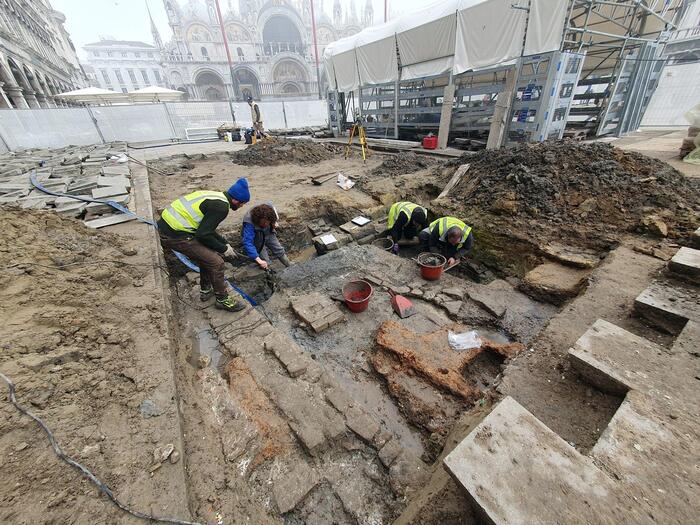There is a medieval past to be discovered that emerges from the construction site of the Superintendence of Venice called to restore the "masegno", the trachyte stones of which the paving of Piazza San Marco is made, after the devastation due to the corrosive action of high water.
From the dark and wet earth, the archaeologists, led by the project manager Sara Bini, extracted the skull of a child who probably lived in the early Middle Ages.
Next to it there are three skeletons which are added to those recovered right in front of the Procuratie Vecchie.
They tell a hitherto unknown story of the Serenissima, the one that revolves around the church of San Gemignano, the church of the Doges, then demolished and rebuilt on the eastern side of the square and finally razed to the ground in the last version of Sansovino by Napoleon, which was located right at the point of discovery.
Overall, the remains of seven people were found in a single collective tomb: a child around the age of 8, a woman and five other adults over fifty, all dating back to a period between the seventh and eighth centuries.
There have been few fixed points so far for the experts: they are mostly "elderly" for the time, with relatively sedentary occupations.
"Piazza San Marco has not always been as we see it today - explains the Facebook post published by the Superintendence of Venice - and now it is not easy to imagine it with canals that crossed it and with churches that characterized it".
How did we get to San Gemignano?
Thanks to the archival sources which say that the sacred building existed in a specific point of the square, but also thanks to the discovery of a burial with brick shoulders within which the remains were found.
A concrete confirmation, after the suspicions that have circulated for decades, that the Venetians have always restored, dismantled and remade the Marcian area by superimposing layers of different nature.
San Gemignano was certainly the oldest church in San Marco.
"It was a common practice for the time that of collective burials - explains Bini -. They were tombs that were reopened: the previous deceased, now a skeleton, was moved to make room for the new arrival".
The hypothesis is that it hosted important people, "since it was not a simple grave - adds the archaeologist - but a masonry tomb with a certain monumentality for the time".
The attention of the experts is now focused above all on the intervention of the Municipality of Venice, destined soon to 'uncover' the entire square for restoration reasons, an area that had not been investigated since 1855.
Reproduction reserved © Copyright ANSA

